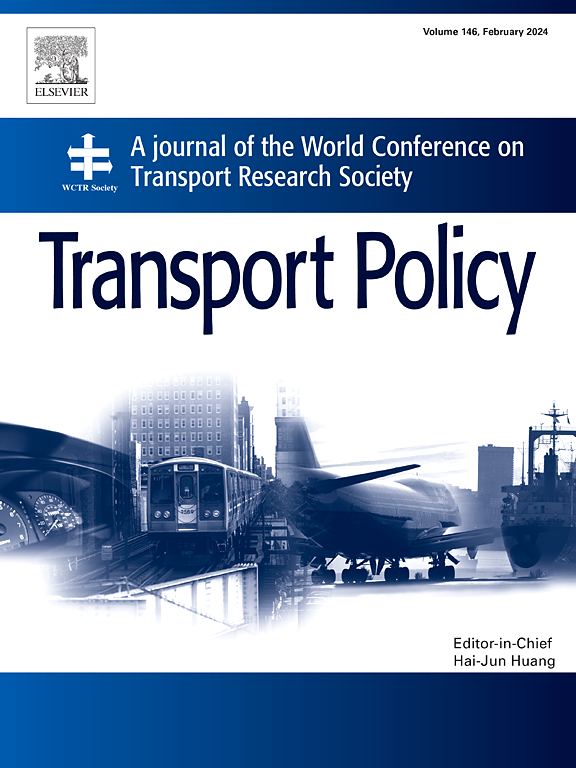How has the COVID-19 pandemic reshaped the aviation network? A comparative pre- and during-pandemic analysis
IF 6.3
2区 工程技术
Q1 ECONOMICS
引用次数: 0
Abstract
The COVID-19 pandemic has profoundly impacted international flights, leading to substantial economic repercussions for the global tourism industry. While existing research has explored the resilience and recovery of the air transport system during the pandemic, this analysis delves into the structural transformation of the air transportation network within “the Belt and Road” region through a quantitative analysis. The findings reveal three critical aspects: (1) The pandemic caused a marked reduction in air transport connectivity, with flight frequency and route connectivity between cities decreasing by 27.82% and 35.87%, respectively, although the basic aviation framework remained intact. This impact varied across different administrative levels, regions, and distances, due to the impact of different countries' pandemic policies. Transnational connections were particularly hard-hit, experiencing more severe disruptions than domestic routes. (2) Significant shifts occurred in the rankings of aviation hubs. For example, cities like Singapore and Doha rose in prominence, while traditional hubs such as Moscow and Beijing saw a decline in their rankings. This shift reflects a reconfiguration of key nodes within the aviation network. (3) The network structure underwent significant reorganization and decentralization, transitioning from a conventional core-periphery model to a hybrid structure that blends core-peripheries with local communities. This transformation demonstrates the network's adaptability and its capacity to develop alternative structures in response to sudden external shocks like the COVID-19 pandemic. The insights from this analysis offer valuable guidance for policy-making and the development of emergency measures to better prepare for and mitigate future disruptions in air transport. The analysis underscores the importance of flexible and adaptive strategies in managing aviation networks, particularly in the face of global challenges.
COVID-19 大流行如何重塑了航空网络?大流行前和大流行期间的比较分析
COVID-19 大流行对国际航班造成了深远影响,给全球旅游业带来了巨大的经济冲击。现有研究探讨了疫情期间航空运输系统的复原力和恢复能力,而本分析报告则通过定量分析深入探讨了 "一带一路 "区域内航空运输网络的结构转型。研究结果揭示了三个关键方面:(1) 疫情导致航空运输连通性明显降低,城市间的航班频率和航线连通性分别下降了 27.82% 和 35.87%,但基本航空框架保持不变。由于各国的疫情政策不同,这种影响在不同的行政级别、地区和距离上也不尽相同。与国内航线相比,跨国航线受到的影响尤为严重。 (2) 航空枢纽的排名发生了重大变化。例如,新加坡和多哈等城市的地位上升,而莫斯科和北京等传统枢纽的排名下降。这种变化反映了航空网络中关键节点的重新配置。(3) 网络结构经历了重大重组和分权,从传统的核心-外围模式过渡到核心-外围与地方社区相结合的混合结构。这一转变显示了该网络的适应性及其发展替代结构以应对 COVID-19 大流行病等突发外部冲击的能力。本分析的见解为决策和制定应急措施提供了宝贵的指导,以更好地应对和缓解未来航空运输的中断。分析强调了灵活和适应性战略在管理航空网络中的重要性,尤其是在面对全球性挑战时。
本文章由计算机程序翻译,如有差异,请以英文原文为准。
求助全文
约1分钟内获得全文
求助全文
来源期刊

Transport Policy
Multiple-
CiteScore
12.10
自引率
10.30%
发文量
282
期刊介绍:
Transport Policy is an international journal aimed at bridging the gap between theory and practice in transport. Its subject areas reflect the concerns of policymakers in government, industry, voluntary organisations and the public at large, providing independent, original and rigorous analysis to understand how policy decisions have been taken, monitor their effects, and suggest how they may be improved. The journal treats the transport sector comprehensively, and in the context of other sectors including energy, housing, industry and planning. All modes are covered: land, sea and air; road and rail; public and private; motorised and non-motorised; passenger and freight.
 求助内容:
求助内容: 应助结果提醒方式:
应助结果提醒方式:


